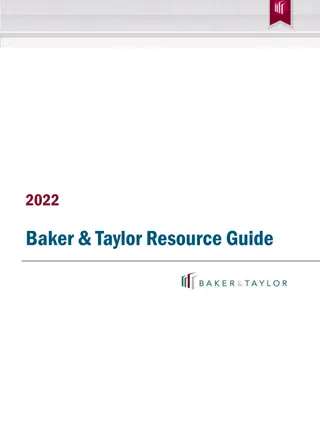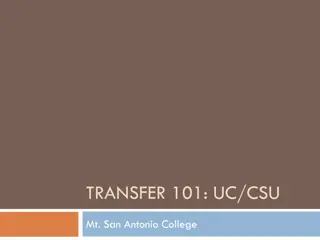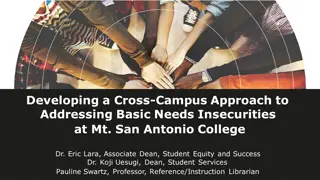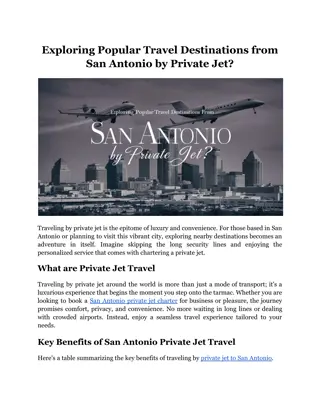Dr. Gail P. Taylor UT San Antonio Research Findings
Research conducted by Dr. Gail P. Taylor at the University of San Antonio on February 28, 2013, is the focus of this content. The study's findings and implications are explored. Dr. Taylor's work sheds light on relevant topics within the field, presenting new insights and knowledge for further examination and discussion.
Download Presentation

Please find below an Image/Link to download the presentation.
The content on the website is provided AS IS for your information and personal use only. It may not be sold, licensed, or shared on other websites without obtaining consent from the author.If you encounter any issues during the download, it is possible that the publisher has removed the file from their server.
You are allowed to download the files provided on this website for personal or commercial use, subject to the condition that they are used lawfully. All files are the property of their respective owners.
The content on the website is provided AS IS for your information and personal use only. It may not be sold, licensed, or shared on other websites without obtaining consent from the author.
E N D
Presentation Transcript
Dr. Gail P. Taylor UT San Antonio 02/28/2013 02/28/2013
Student Conference Presentation 15 minute presentation 10 Minutes Talk 5 minutes for questions At most, 15 slides
Title Slide: Strong title, your name, mentor, school. Introduction/Background (2-3 slides). Why/How is your topic important (health?) Give brief literature background (broad to specific) Goals of project Hypothesis Methods and exptl design (1 to 2 slides- flowcharts good) Results (1 2 experiments) 2-3 slides Summary/Conclusions Bulleted and refer back to hypothesis Future Directions Acknowledgements Questions?
Uniform Font Uniform title size and position Short phrases ~Six lines per page Story carried by images Contrast between background and text All text big (even on figs)
NOTE! I have Made up all of the data in this study. Ergot-Derived Substance-X Reduces Tumor Growth and Size in Nude Mice with MCF-7 Mammary Adenocarcinoma Emily P Frogbottom Undergraduate Research Trainee Research Mentor: Dr. Tenure Track University of Texas at San Antonio
Introduction Breast Cancer 100,000 diagnoses annually1 Leading cause of death in women 15-541 Vary in metastatic capacity Vascularization required for growth/metastasis MCF-7: Human adenocarcinoma cell line 1 Centers for Disease Control, 2010
Introduction Treatment Generally surgery & chemotherapy Mortality __% at 5 years1 More effective chemotherapeutic agents needed Some work by inhibiting vascularization2 2 De Olivera, L, Hamm A, Mazzone M (2011) Mol Aspects Med. 2011 Apr;32(2):71-87. Epub 2011 Apr 22
Introduction - Ergot Claviceps purpurea fungus Cocktail of active substances CNS - Psychoactive Ergotamine ~LSD Peripheral Effects Tingling- St. Anthony s Fire Inhibit vascularization and promotes gangrene Vasoactive Substance-X isolated3 Inhibits growth of cultured endothelial cells3 3Taylor, GP (2011) Terrific thought experiment on using a deadly scourge to humanity to cure cancer. Journal of Positive Data 3(3), 210-212
Hypothesis MCF-7 tumor growth will be inhibited through treatment with vasoactive Substance-X. Inhibition will be associated with reduced angiogenesis
Experimental Design/Methods Induction Culture Treatment Analysis Weekly caliper measurement 8 weeks sac Cryosection ICC anti-BV Density Test Stats T-Test SubQ injections Control (solv) 1, 10 100 uM SubX Daily for 8 wk Athymic mice N=40 (4 grps) SubQ Injection Thigh 106/50ul 1 mo growth MCF-7 Cells DMEM 2 weeks <40% conf.
Results Substance-X Inhibited MCF-7 Tumor Growth * * * * * * * * * * P< 0.01
Results Control 1 uM Angiogenesis Inhibition 100 uM 10 uM 200X * *
Conclusions Substance-X (10 uM 100 uM) inhibits growth of MCF-7 tumors in athymic mice Angiogenesis significantly inhibited at higher dosages Hypothesis retained Substance-X may be a powerful treatment against adenocarcinoma breast tumor growth
Future Directions Establish LD-50 curve Explore concentrations Vary treatment schedules Examine effects on metastasis Compare with standard chemotherapeutic agents
Acknowledgements Dr. U.R. Fakedata, UTSSSA Belinda Doolittle Jason Trimple MBRS-RISE GM 60655 MARC-U*STAR GM 07717
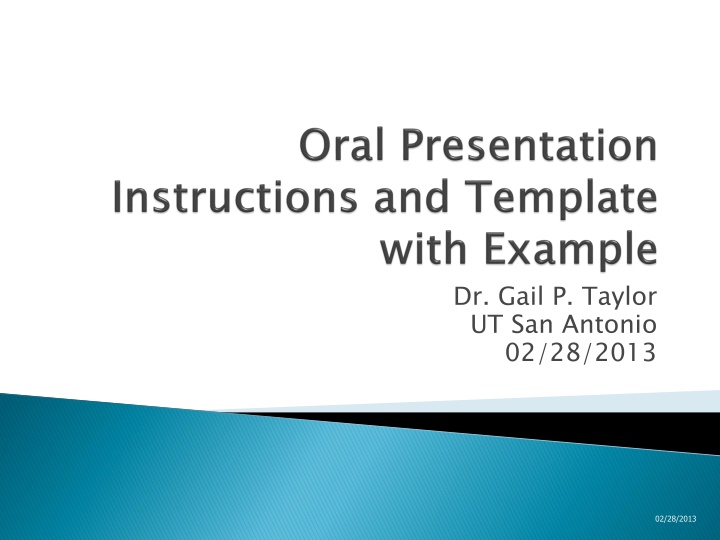




![(❤Read⚡) [✔PDF✔] The Best Travel Guide - San Diego: A Cicerone’s View of To](/thumb/68088/read-pdf-the-best-travel-guide-san-diego-a-cicerone-s-view-of-to.jpg)







